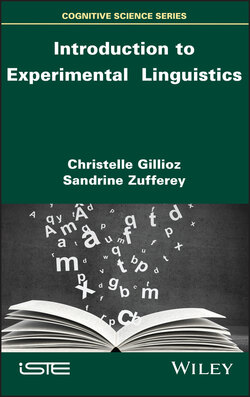Читать книгу Introduction to Experimental Linguistics - Sandrine Zufferey - Страница 20
1.3.3. Offline and online measures of comprehension
ОглавлениеThe various tasks listed above, as well as the tasks proposed in the examples presented so far in this chapter, enable access to comprehension once the word, sentence or text has been processed and understood. These measures are described as offline, in that they affect the final interpretations resulting from the comprehension process. On the other hand, online measures allow us to study the processes that come into play in comprehension itself. Such processes have the characteristic of being extremely fast, transient and occurring out of people’s consciousness, therefore remaining inaccessible to traditional offline measures.
Borrowing scientific methods and paradigms from other disciplines, such as psychology, has allowed the study of online processes involved in language comprehension. The majority of online measurement techniques have something in common: they observe the time required for a process, by measuring the reading time or reaction time. These techniques are based on the idea that the time required to complete a process reflects certain characteristics of this process, particularly in terms of complexity. Longer reaction times and reading times are generally associated with a more in-depth processing of the linguistic stimulus. Tasks using these time measures typically involve asking participants to name words, read or produce sentences, or decide whether or not a series of letters matches a word in their language. Studies that have employed such tasks have shown that, at the word level, response times and reading times are influenced by properties such as frequency, length and predictability. Similarly, at the sentence level, reading is influenced by properties such as syntax complexity or the need to produce inferences (Just and Carpenter 1980; Rayner 1998; Smith and Levy 2013).
Studies based on time measures have benefited from significant technological developments since the 1970s, so that today, anyone can easily conduct research from their computer. In addition, new techniques have been developed to enable the recording of eye movement whilst reading or when observing an image. It is thus possible to gain an insight, not only into the time required to read certain words or sentences, but also the exact movements made by the eyes during reading. This data provides additional information, such as the time allotted for different words, the order in which words are fixated or even the eye movements associated with reading certain passages. These eye movement measures can be applied to the study of reading as well as to the study of spoken speech production or comprehension.
Finally, the methods used in the field of neuroscience have also been transferred to experimental linguistics. These methods provide access to the brain activity involved in language-related processes. Using small electrodes placed on the scalp, the electroencephalogram (EEG) records the activity of neurons on the surface of the brain. This technique gives an accurate temporal overview of the activity of neurons associated with a specific linguistic process. Functional magnetic resonance imaging (fMRI) aims to measure the activity of neurons based on their oxygen consumption. It thus provides a precise spatial overview of the brain areas involved in a specific linguistic process.
As we can infer by reading these lines, offline methods are the most accessible to researchers, since they require few technical means. In most cases, offline measures can be collected using paper and pencil tasks. A simple spreadsheet available on every computer can be used for organizing and analyzing the data from such studies. For some statistical tests, a program must be added to the list of necessary tools. Online methods for observing reaction time or reading performance require special software for programming experiments. Things get more complicated when you want to record eye movements. These recordings require the use of expensive tools, that also take time to control. Furthermore, the data from studies on eye movements is much more complex to process. Finally, EEG or fMRI studies are generally reserved for people benefiting from access to such techniques, which are extremely costly in terms of equipment and necessary skills for processing recorded signals. For this reason, such techniques will not be discussed in this book.
Finally, we should point out that the offline and online measures do not provide answers to the same type of research questions. It is therefore important to consider them as complementary measures, which shed different light on the same phenomenon. There are no good or bad measures in experimental linguistics; the choice must be made on the basis of the goals and hypotheses of the research project. More and more often, offline and online measurements are used in parallel in the same study. We will return to these measures, their specific characteristics and the means for combining them, in detail, in Chapters 4 and 5.
